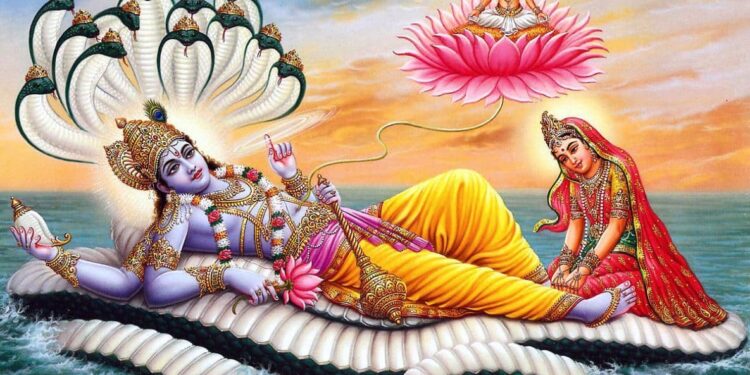Lord Vishnu is one of the most prominent and revered deities in Hinduism. He is considered the preserver of the universe and is believed to have incarnated on earth several times to restore order and protect righteousness.
According to Hindu mythology, Lord Vishnu is depicted as having a blue complexion and four arms, holding a conch shell, a discus, a mace, and a lotus flower. The conch shell symbolizes the sound of creation, the discus represents the cycle of time, the mace signifies mental and physical strength, and the lotus flower symbolizes spiritual enlightenment.
Lord Vishnu is also associated with his ten avatars, or incarnations, including the popular ones like Lord Rama and Lord Krishna. Each avatar represents a different aspect of Lord Vishnu’s personality and is believed to have taken birth on earth to restore balance and harmony in the world.
Lord Vishnu is worshipped by millions of Hindus around the world, and his temples are spread throughout India and other countries. Devotees offer prayers, perform rituals, and chant his name to seek his blessings and guidance in their lives.
In Hinduism, Lord Vishnu holds immense significance and is considered to be one of the most powerful and benevolent deities. His teachings and stories have been passed down through generations, inspiring people to lead a righteous and virtuous life.
There are many symbols associated with Lord Vishnu that hold significant meaning and represent different aspects of his divine nature.
Conch shell (Shankha)
The conch shell is one of the most recognizable symbols of Lord Vishnu. It represents the primordial sound of creation, which is believed to have brought the universe into existence. The conch shell is also used as a musical instrument during religious ceremonies.
Discus (Chakra)
The discus represents the cycle of time and is often depicted as a spinning wheel. It symbolizes Lord Vishnu’s power to destroy ignorance and bring about the end of the universe.
Mace (Gada)
The mace represents Lord Vishnu’s strength and power. It is a symbol of his ability to overcome obstacles and defeat evil forces.
Lotus (Padma)
The lotus symbolizes purity and divine beauty. Lord Vishnu is often depicted sitting on a lotus flower, which represents his ability to rise above the material world and attain spiritual enlightenment.
Serpent (Shesha)
The serpent represents Lord Vishnu’s power to control and subdue the forces of nature. It is often depicted as a coiled snake around Lord Vishnu’s neck, and it symbolizes his ability to protect the world from harm.
Crown (Mukut)
The crown represents Lord Vishnu’s divine sovereignty and authority. It symbolizes his position as the supreme ruler of the universe.
Blue skin (Neela Megha Shyama)
Lord Vishnu is often depicted with blue skin, which represents his transcendental nature. The color blue symbolizes the infinite and the immeasurable, and Lord Vishnu’s blue skin represents his divine consciousness and spiritual purity.
In Hindu mythology, Lord Vishnu is revered as the protector of the universe and is believed to have taken on various avatars (incarnations) to restore balance and order to the world. The symbols associated with Lord Vishnu represent his divine qualities and serve as reminders of his power and presence in the world.


















Discussion about this post